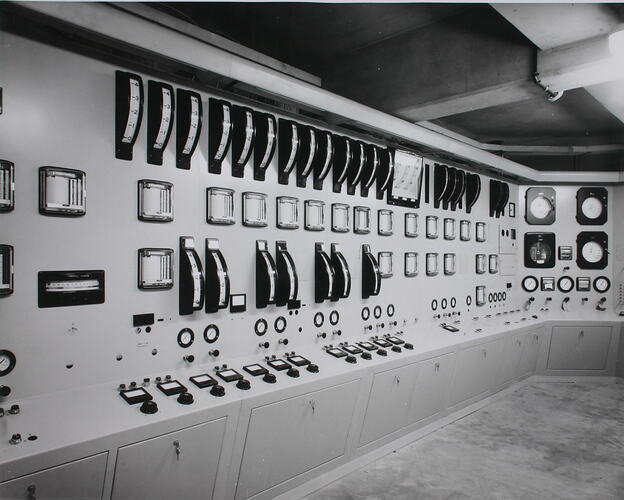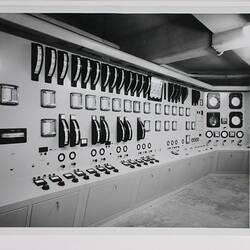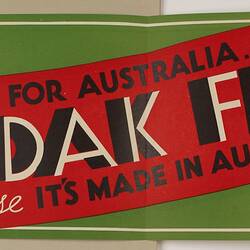Summary
Black and white silver gelatin photograph features the instrument and control panel in the control room (Monitor Room) where the operation of the emulsion coating machine was conducted in Building 3, Emulsion Coating Department, Kodak factory complex in Coburg, circa 1964.
Photo-sensitive emulsion in gel form was made in Building 2, Emulsion Making Department, and transferred in 'kettles' to Building 3 where it was coated on to the film or paper base master rolls using this machine. The coated master rolls were then transferred to the various finishing operations throughout the factory complex.
The coating machine (which occupied most of the Building 3 area), consisted of four sections. One section comprised an unwinder and winder with magazine storage and splicers enabling the master rolls to be handled continuously at the input and output respectively. The coating section was where the liquid emulsion was drawn down from the kettles and laid down on to the base (film or paper). In the chilling section, emulsion was set to a gel consistency and in the drying section, the wet emulsion was dried in a very controlled manner to avoid mechanical disturbance and desensitisation.
The transport of very wide master rolls required accurate steering devices and controlled torque drive rollers throughout this machine. Many other proprietary devices controlled parameters such as emulsion flow, emulsion laydown, emulsion to base adhesion and electrostatic minimisation. Air conveyance systems in the chiller and dryer kept the wet emulsion surface from touching any mechanical drive rollers. The coating machine was operated under strictly controlled cleanroom and darkroom conditions to avoid triggering photo development within the emulsion. Allied equipment such as fan motors, air conditioning steam and chilled water lines and valves and circuit breakers, were all located outside the cleanroom environment in order to limit entry of dirt and for easy access by tradespeople.
Since the operators worked in almost complete darkness, they were relieved of most instruments and controls checking so that they could safely devote their whole time to the product and the machine. The Monitor Room contained all instruments and most controls for the coating machine. The monitor (supervising operator) commanded the whole operation from a desk in this room (not shown) with an alarm panel, footage counters and an intercom system, communicating with all operator workstation. A second operator monitored all the instruments and controls shown in this photograph. Along the long wall panel on the left of the photograph were instruments and controls for dryer air pressures, dryer wet and dry bulb temperatures, steering frame widths and suction drive rollers speed and torque. On the wall panel at the rear were the instruments and controls for the drawdown and flow of the emulsion to the coating head.
Kodak manufactured and distributed a wide range of photographic products to Australasia, such as film, paper, chemicals, cameras and miscellaneous equipment. Its client base included amateur and professional photographers, as well as specialist medical and graphic art professionals who used photography, x-ray and other imaging techniques.
This photograph is part of the Kodak collection of products, promotional materials, photographs and working life artefacts collected from Kodak Australasia in 2005, when the Melbourne manufacturing plant at Coburg closed down.
Description of Content
Photograph of a control room where instruments and controls can be seen mounted along a wall panel running down the left side and at the back of the room.
Physical Description
Black and white, silver gelatin photograph printed on light weight paper, landscape format.
More Information
-
Collection Names
-
Collecting Areas
-
Acquisition Information
Donation from Kodak (Australasia) Pty Ltd, Ms. Kate Metcalf - Kodak (Australasia) Pty Ltd, 2005
-
Acknowledgement
Courtesy of Kodak (Australasia) Pty Ltd.
-
Place & Date Depicted
-
Organisation Depicted
Kodak (Australasia) Pty Ltd, Coburg, Greater Melbourne, Victoria, Australia, circa 1964
-
Format
Photograph, 8" x 10", Black & White
-
Language
English
-
Classification
Manufacturing & industry, Photographic products, Factory interior views
-
Category
-
Discipline
-
Type of item
-
Keywords
Control Rooms, Factories, Machines, Manufacturing Plants, Photography, Making History - Kodak Collection



